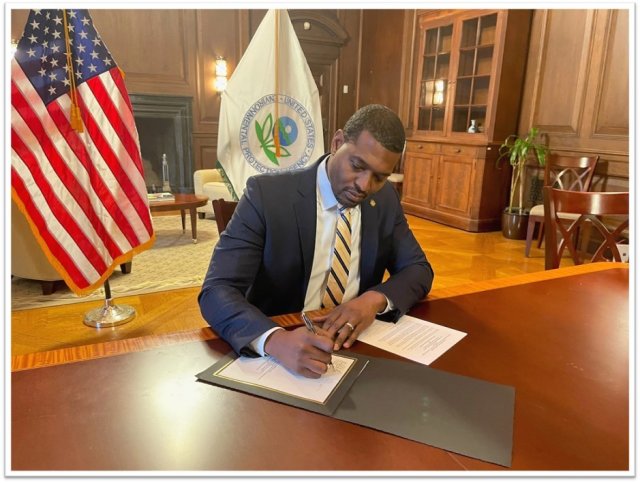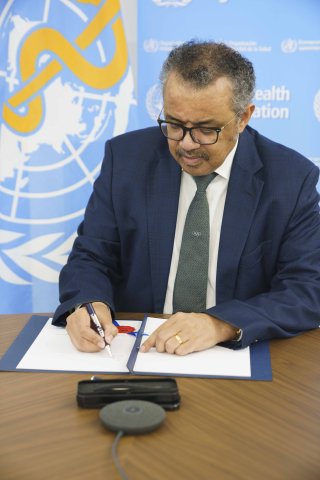U.S. EPA and World Health Organization Partner to Protect Public Health
Agreement recognizes the increased environmental and public health risks from the warming global climate and prioritizes environmental justice.
WASHINGTON (Jan. 20, 2021) –This week, the U.S. Environmental Protection Agency (EPA) and World Health Organization (WHO) signed a five-year Memorandum of Understanding (MOU). The agreement continues EPA-WHO collaboration on a wide range of specific and crosscutting environment and health issues, particularly air pollution, water and sanitation, children’s health, and health risks due to climate change. The updated agreement includes exciting new actions on crosscutting issues including infrastructure and environmental justice.
“I am proud to renew EPA’s commitment to working with the WHO to protect the public from the health risks of pollution,” said EPA Administrator Michael S. Regan. “The United States is committed to working closely with WHO, a global leader in protecting human health for all, with a particular focus on addressing the needs of vulnerable and underserved communities. As we face new challenges from climate change and the COVID-19 pandemic, this collaboration with the WHO has never been more critical.”
EPA’s mission to protect human health and the environment fully aligns with WHO’s charge to lead global efforts to promote health for everyone, everywhere. The WHO estimates that 24% of all global deaths, and 28% of deaths among children under five, are linked to the environment, and people in low- and middle-income countries bear the greatest disease burden.
“The COVID-19 pandemic has highlighted the intimate links between humans and our environment,” said WHO Director-General Dr Tedros Adhanom Ghebreyesus. “Addressing those links is essential to prevent diseases, including future pandemics, to promote health, drive the global recovery and reduce health risks associated with climate change, especially for the most vulnerable. WHO looks forward to continuing its longstanding collaboration with US EPA, and to tapping EPA’s expertise to advance our mission to support countries in meeting the challenges of environmental health.”
EPA and WHO have a long history of collaboration on the most pressing public health issues of our time. Over three decades, this cooperation has included work on climate change, indoor and outdoor air quality, children’s environmental health, chemicals and toxics, water and sanitation, and quantifying the environmental burden of disease.
Over the next five years, EPA and WHO will focus on addressing the health impacts of climate change. Ongoing efforts will address many environmental determents of health affected by climate change, including clean air and safe drinking water. Collaboration will also continue to focus on protecting children by reducing exposure to toxic substances, in particular lead-based paint.
In this MOU, EPA and WHO have established new areas of cooperation to advance shared priorities around crosscutting issues including addressing the disproportionate impacts of environmental challenges on underserved and vulnerable communities. Protecting these populations and increasing access to decision-making is at the core of Administrator Regan’s vision for the EPA. WHO’s Triple Billion targets outline an ambitious plan for the world to achieve good health for all. Both EPA and WHO prioritize using science as the basis for policies and programs to address environmental health impacts.
WHO also overseas global coordination efforts to respond to the COVID-19 pandemic. EPA is also contributing to COVID-19 response with efforts to register disinfectants for SARS-CoV-2 and researching into antimicrobial products and studies of ways to disinfect personal protective equipment so that it could be reused. EPA has worked to early warning systems by monitoring wastewater for the presence of SARS-Cov-2. The two agencies will continue to advance biodefence science to respond to the current pandemic and be better prepared for all biothreats in the future.
BACKGROUND
About the World Health Organization (WHO)
Founded in 1948, WHO is the United Nations agency that connects nations, partners and people to promote health, keep the world safe and serve the vulnerable – so everyone, everywhere can attain the highest level of health. The mandate of WHO's Health and the Environment programme is to support Member States to improve health outcomes linked to environmental risks such as: Unsafe water and inadequate sanitation; Poor indoor and outdoor air quality; Exposure to toxic or hazardous waste and chemicals.


